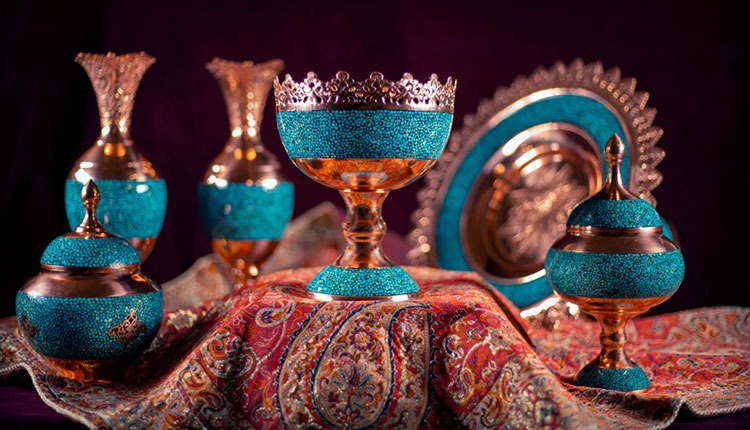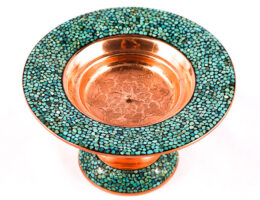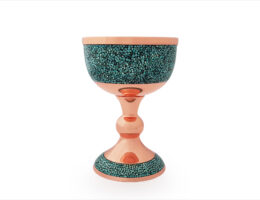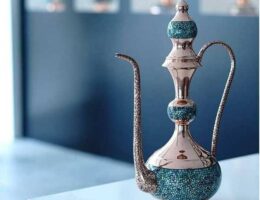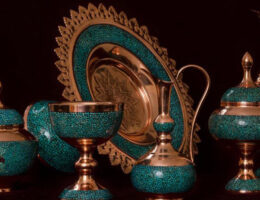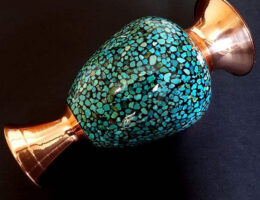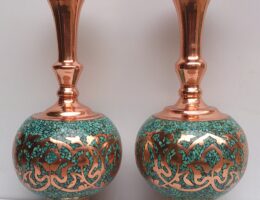IRAN ART EXHIBITION: DIFFERENT STAGES OF PRODUCTION OF TURQUOISE INLAYING
Persian Turquoise Inlaying (Persian: فیروزه کوبی FIROOZEH KOOBI) is one of the modern arts that dates back to 70 years ago. About 70 years ago, Professor Yousef Hakmian founded this art in Mashhad. After that, Haj Dadash promoted the art of turquoise carving in Isfahan about 20 years later and performed it in this city.
Today, it is one of the most important Turquoise Inlaying bases in Isfahan, and many artists and craftsmen have set up turquoise workshops in this city.
Regarding the history of Turquoise Inlaying, you should say that Turquoise Inlaying is not very long, but due to the use of precious turquoise stone and the beauty of its design, it is highly valued.
History of Turquoise
Turquoise is one of the precious stones that has been known in Iran since ancient times. The inscription of the foundation of the palace of Darius the Great in Susa shows that turquoise was used to decorate the palace. Turquoise is the wish stone of the kings of all civilizations since the time of Cyrus and Darius the Great, which was given as a gift by them to the kings of other countries. Persian turquoise is the highest quality turquoise in the world, and in Europe, Persian turquoise is used as an example to define the quality of turquoise.
The oldest turquoise mine in Iran, which some people know is nearly 10,000 years old, is the Neishabour mine.
Definition and Usage of Turquoise Inlaying
Turquoise Inlaying is a product made of copper, brass, silver, Warsaw or bronze, in which particles and small pieces of turquoise stone are placed together on a part of its surface in a mosaic form, and thus the effect A special be given to it.
Turquoise Inlaying is an art-industry in the division and classification of Iranian handicrafts, which has an artistic and aesthetic aspect and has a decorative application. Turquoise Inlaying is mostly used for decorating jewelry, vases, candlesticks, mirror frames, etc.
Stages of Manufacturing and Production of Turquoise Inlaying
IRAN ART EXHIBITION: In general, manufacturing and polishing Turquoise Inlaying products includes the following steps:
The first stage The surface under the work of the desired metal such as brass, copper and silver is made by a goldsmith or metal maker with the help of hand or press machine and smooth and polished enters the next stage.
The second step is to separate the turquoise stones according to their size and so-called granulation so that in the construction of each turquoise product, a piece of turquoise is used that is more appropriate to the turquoise work surface. Then the stones are glued to the product with a special glue.
The third stage is payment. At this stage, the turquoise surfaces are polished and then polyester is applied on it, which is due to the protection of the work surface and also the maximum beauty of the effect.
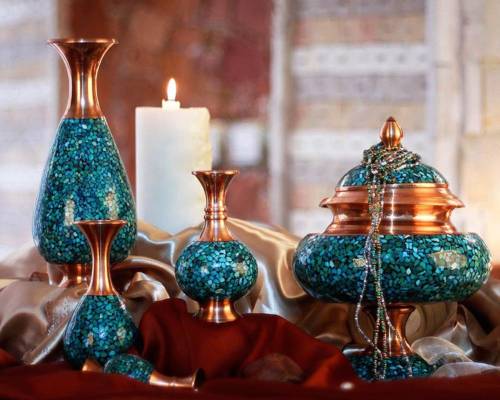
Iran is one of the world’s most prolific countries in producing decorative gemstones, and its sky-blue turquoise has always been a magnet for beauty seekers throughout history.
The word turquoise, which dates to the 16th century, is derived from an Old French word for “Turkish”, because the mineral was first brought to Europe through Turkey from the mines in Iran. The Iranians named it “pirouzeh” (meaning victory) and the Aztecs knew it as Teoxihuitl.
It is an opaque stone, which differs in shade from blue, green and blue-green depending on its origin. It is rare and valuable in finer grades and has been prized as a gem and ornamental stone for thousands of years owing to its unique hue. It takes a fine polish and does not lose color with time.
Persian turquoise is extensively found in Iran’s northeastern city of Neyshabur (Nishapur) and dates back to 4,000 BCE. Neyshabur turquoise mines, located 53 kilometers northwest of the city and near the old caravan routes, are believed to be among the world’s oldest known turquoise mines, which supplied the stone to Europe, Western Asia and America.
In Persia, turquoise was the de facto national stone for millennia, extensively used to decorate objects (from turbans to bridles), mosques, palaces and other important buildings. The massive, robin’s egg blue Persian turquoise is used in making jewelry and creating mosaics, inlays or overlays that have adorned numerous monuments over the centuries.
IRAN ART EXHIBITION: The Persian style and use of turquoise was later brought to India, its influence seen in high purity gold jewellery (together with ruby and diamond) and in such buildings as the Taj Mahal. Archeological excavations have yielded Persian turquoise in ancient graves in Turkistan and throughout the Caucasus dating back to the first to third century BCE.
Iranian artists use turquoise in various forms of art including calligraphy and handicrafts. Inlaid turquoise is one of the most beautiful Iranian artworks. It is made by implanting small pieces of turquoise stone in mosaic fashion on the surface of the dishes, ornaments and decorative objects with copper, brass, silver or bronze bases.
